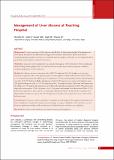Please use this identifier to cite or link to this item:
https://hdl.handle.net/20.500.14356/1960| Title: | Management of Liver Abscess at Teaching Hospital |
| Authors: | Shrestha, S K Joshi, R Dongol, U MS Singh, D R Sharma, S K |
| Citation: | ShresthaS. K., JoshiR., DongolU., SinghD. R., & SharmaS. K. (2011). Management of Liver Abscess at Teaching Hospital. Journal of Nepal Health Research Council. https://doi.org/10.33314/jnhrc.v0i0.247 |
| Issue Date: | 2011 |
| Publisher: | Nepal Health Research Council |
| Article Type: | Original Article |
| Keywords: | Liver abscess Clinical features Percutaneous drainage and management |
| Series/Report no.: | April;247 |
| Abstract: | Abstract Background: A current assessment of liver abscesses should allow for better understanding of the pathogenesis of the disease and improve the effectiveness of diagnosis and treatment. Amoebic liver abscess occurs more commonly than the pyogenic liver abscess on a worldwide basis. The purpose of the study is to investigate the clinical presentation and management option for liver abscess. Methods: A prospective observational study was conducted from January 2007 to December 2010, in Kathmandu Medical College Teaching Hospital. We recorded and analyzed the clinical presentations, diagnostic modalities, treatment programmes of all liver abscesses. Results: Liver abscess was more common in males, 24(85.7%) males and 4(14.3%) females, occurring more frequently in right lobe of liver. Most patients presented with nonspecific clinical and biochemical features. Twenty (71.4%) patients presented with chills & rigors. Five patients (17.8%) presented jaundice and none had transaminases raised but 15(56.3%) had raised alkaline phospahatases. Eight (28.5%) patients were treated with antibiotics alone. USG guided drainage was done in 12(42.8%) patients and 6(21.4%) required surgical exploration with laparoscopic deroofing in 2(7.1%) patients. The largest size was 1100cc.with right lobe predominance in 20(76.9%) patients and single lobe involvement in 22(78.4%) patients. Six (21.4%) patients had multiple liver lobes involved. Three (7.1%) patients had ruptured liver abscess and 3(7.1%) had right sided pleural effusion. Seventeen (60.7%) patients were diagnosed have amoebic liver abscess. Ten (35.7%) patients were found to have pyogenic liver abscess. One (3.5%) had tuberculosis. Conclusions: Liver abscess requires a high degree of suspicion for early diagnosis. When appropriate therapy in the form of antibiotics in combination with percutaneous drainage or surgery is administered the mortality is very low. However, significant morbidity is still a problem in old debilitated persons with other core morbidities. Keywords: liver abscess, clinical features, percutaneous drainage and management. |
| Description: | Original Article |
| URI: | http://103.69.126.140:8080/handle/20.500.14356/1960 |
| ISSN: | Print ISSN: 1727-5482; Online ISSN: 1999-6217 |
| Appears in Collections: | Vol 9 No 1 Issue 18 April 2011 |
Files in This Item:
| File | Description | Size | Format | |
|---|---|---|---|---|
| 247-Article Text-245-1-10-20130822.pdf | Fulltext Download | 130.97 kB | Adobe PDF |  View/Open |
Items in DSpace are protected by copyright, with all rights reserved, unless otherwise indicated.
